Introduction
Relatively few cultivars of apples (Malus domestica L.) have been reported to be grown successfully in Florida. Northern apple cultivars, such as 'Golden Delicious', 'Red Delicious', 'Gala', or 'Fuji', are not exposed to enough low temperatures during Florida's mild winters. Apple cultivars have what is known as a chilling requirement. Chilling requirement is the amount of cold temperatures during the winter required for normal vegetative and reproductive growth in the spring. The chilling requirement may be determined by the cumulative number of hours less than or equal to 45°F during the winter. Each hour is referred to as a chill unit. There are relatively few apple cultivars with a low enough chilling requirement to be successfully grown in Florida.
Although many homeowners in north Florida and north central Florida grow apple trees, there is little potential for establishment of commercial apple orchards in Florida. The lack of commercial potential is because apples are available year-round from the Pacific Northwest, and apples are also available from south of the equator during our winter and spring. In addition, the successful culture of apples in Florida is more difficult than in most temperate regions due to high rainfall, humidity, and insect and disease pressure during the apple-ripening season, late May through August.
However, several low-chill cultivars have been developed and can be productive in Florida. While not likely to be profitable in commercial production, apples have been successfully grown by homeowners and may be profitable for small farms. This article provides a general overview on low-chill apple production, particularly in north Florida, to county and state Extension faculty, growers, homeowners and students who are interested in growing apples.
Site Requirements
Apple trees perform best in locations that receive full sunlight. Apple trees need consistent sunlight. Branches that are more sunlit are more fruitful and produce bigger fruit than those with less sunlight. Also, areas that receive shade more than half of the day are not suitable for growing apples. Early-morning sun is more important than early-evening sun due to the negative impact of morning dew on leaves and fruit.
Locations and cultural practices that foster air movement should be encouraged to minimize disease problems associated with high humidity. Planting on hilltops is preferable to low-lying areas because hilltops facilitate good air circulation and drainage of surface water.
Apple trees grow well in most soils in north Florida and north central Florida, provided that the areas are well drained. A soil pH of 6–6.5 is best for growing apples. For a soil pH of less than 5.0, add 4–6 lb/100 sq. ft. of lime prior to planting. Few soils in north Florida have a native pH greater than 7.0. However, application of elemental sulfur of 1–2 lb/100 sq. ft. will lower pH about 1 unit. In poorly drained soils or soils in low-lying areas, apple trees will succumb to anaerobiosis and/or Phytophthora root rot. In extremely sandy soils, apple trees will have to be supplied with irrigation more frequently, especially for newly planted young trees.
Apple Cultivars
Apple cultivars that may be suitable for north Florida and north central Florida have a chilling requirement of less than 600 and 400 hours, respectively. A summary of apple cultivars evaluated in Florida is presented in Table 1.
Of the 43 cultivars tested, only 'Anna' (Figure 1), 'Dorsett Golden' (Figure 2), and 'TropicSweet' are recommended for Florida. 'Anna' was bred in Israel in 1959, while ‘Dorsett Golden’ originated in the Bahamas in the early 1950s. 'TropicSweet' was patented by the University of Florida in 1995. These cultivars each have a chilling requirement of 250–300 hours. They also require the accumulation of a substantial amount of heat units before trees will bloom in the spring. Consequently, these three cultivars can be grown in Ocala and northward in Florida.
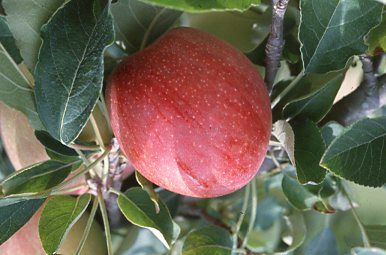
Credit: UF/IFAS NFREC
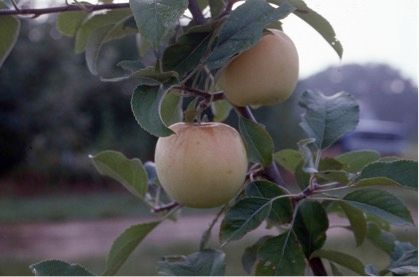
Credit: UF/IFAS NFREC
While frost injury to flower buds is common on most low-chill apple cultivars, such cultivars also exhibit a prolonged bloom period in late winter (usually late February), so that the later blooms often escape freeze injury and allow for a potential crop.
Most apple cultivars are not self-fruitful; more than one cultivar should be planted together for cross pollination. 'Anna', 'Dorsett Golden', and 'TropicSweet' all serve as pollinizers to each other. Fruit ripens on these three cultivars from late May through June. Full bloom and fruit ripening are generally two to three weeks earlier in north central Florida than in north Florida. All three cultivars have good keeping quality and will last six to eight weeks with refrigeration. Fruit characteristics of these cultivars are listed in Table 2.
Fruit of 'Anna' resembles that of 'Red Delicious' more than other low-chill apple cultivars (Figure 3). Fruit of 'Anna' typically attains a size of 2 ¼–2 ½ inches with a 50 percent red blush and good flavor. These trees are upright to semi-spreading and medium in height. 'Anna' is the most widely planted apple cultivar in Florida. 'Dorsett Golden' fruit has good flavor, golden skin, and resembles 'Golden Delicious' fruit. Fruit of 'Dorsett Golden' are 2–2 ½ inches, slightly smaller and firmer than fruit of 'Anna'. 'Dorsett Golden' fruit have a 30 percent light-red blush that covers a yellow ground color. Trees are medium in height, upright and semi-spreading. 'TropicSweet' fruit are sweeter (14–15° Brix) and firmer than fruit of 'Anna’ but are less red and less acidic. 'TropicSweet' fruit have a 30 percent red blush and are subject to skin russeting in some years. Russeting is a brown discoloration and roughened skin). 'TropicSweet' trees are semi-spreading and medium height.
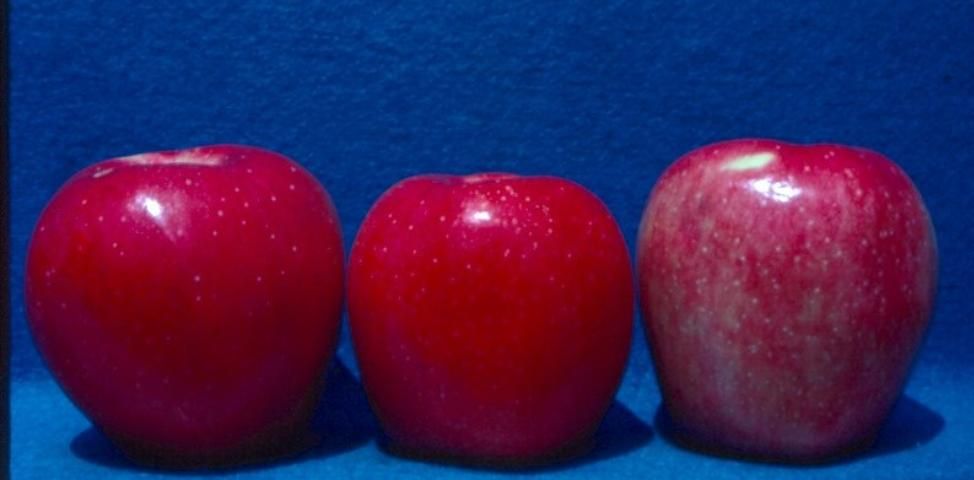
Credit: W. Sherman, UF/IFAS
A second tier of apple cultivars, conditionally recommended for Florida includes 'Ein Shemer', 'Elah', 'Maayan', 'Michal', and 'Shlomit'. These cultivars, all from Israel, ripen later in the summer when high rainfall as well as insect and disease pressures are very high in Florida. The fruit characteristics of these conditionally recommended cultivars are presented in Table 2.
Other Southern varieties have been reported to produce in Florida but were not included in this formal assessment. Production from ‘Cox Winter’, ‘Shell of Alabama’, ‘Joy’, and ‘Terry Winter’ has been reported, with ‘Cox Winter’ and ‘Shell of Alabama’ flowering approximately at the same time as described Florida cultivars.
Rootstock
A problem that apple growers frequently encounter worldwide is that trees become overly vigorous and very large when planted on seedling rootstocks. However, 'Anna', 'Dorsett Golden', and 'TropicSweet' are spur-type trees and, as a result, do not produce large trees on seedling rootstock. Use of a dwarfing rootstock for dooryard planting of these cultivars may further reduce tree size. Many dwarfing apple rootstocks have been developed that reduce vegetative growth of scions, compared to seedling rootstocks.
A rootstock trial was initiated during January 1988 at the UF/IFAS North Florida Research and Education Center (UF/IFAS NFREC) in Monticello, FL. Apple rootstocks included in the trial were Mark, M7A, P22, and MM106. Seedling rootstocks were initially included in the experiment but were deleted from the study because the scion cultivars were not true to type from the nursery. A summary of rootstock characteristics appears in Table 4.
'Anna' or 'Dorsett Golden' were grafted onto each rootstock. The experiment was designed and analyzed as a 2×4 factorial design. Each rootstock/scion was replicated five times. Trees were trained to a modified central leader system. In October 1990, trunk diameter at 2 feet above the ground and tree height were measured.
Trees on M7A or MM106 were subjectively rated as acceptable. However, trees on Mark or P22 were unacceptable because of inadequate vigor and poor health.
Because trees are pruned yearly, tree size is not as accurate an indicator of relative vigor as is trunk diameter. However, this trial indicated that trunk diameter and tree height were both significantly affected by rootstock, and these variables were not affected by scion (Table 3). Trunk diameter and tree size were greater for trees on M7A or MM106 than either Mark or P22. For example, mean trunk diameters of M7A or MM106 varied between 2.0–2.2 inches. By contrast, trunk diameter of Mark or P22 was between 0.7–1.5 inches. Burr knots (a swollen mass of gall-like tissue above the graft union) were also prominent on Mark or P22 rootstocks. This physiological disorder results from incompatibility of the scion and rootstock and sometimes causes adventitious root formation.
There are reports of trees performing well on MM111 rootstocks. Current trials are assessing growth on additional rootstocks, including MM111, Geneva 890, and Bud9/Bud10. These dwarfing rootstocks are recognized for their vigor and resistance to major Florida pathogens.
Planting
Healthy, bare-root trees that are 1 to 2 years old and obtained from a nursery should be planted without allowing the roots to dry. Planting apple trees at the right time is crucial. The time of planting may differ depending on the climate. In a colder climate, planting should be done in the early spring, but in a warmer climate there is more flexibility. For example, planting could be done in the dormant season. However, planting apples trees in Florida from late December to February will allow sufficient time for roots to become established before spring growth begins. When transplanting container-grown trees, care should be taken to spread the roots. Trees purchased in containers can be planted throughout the year provided adequate water is applied throughout the dry spring months and other dry periods during the establishment year.
Planting holes should be large enough to ensure that the root system is neither crowded nor bent. Extra-long or broken roots can be cut. Trees should be planted at approximately the same depth as in the nursery. Put a small amount of soil into the hole, pack the soil around the roots, and repeat this procedure until the hole is full of soil and the plant is firmly in place. After planting, make a soil ring around the edges of the hole to form a reservoir for water. This reservoir should then be filled with water to settle the soil around the roots. Do not fertilize at planting, and never put fertilizer in the planting hole.
Cultivation
Cultivation is usually necessary only for weed control and should be as shallow as possible to avoid damage to the root system. An area approximately 4–6 feet from the trunk should be maintained weed-free. Chemical weed killers with low human/animal toxicity are usually practical for home use. When using pesticides, always follow label directions. Prior to application of herbicides, all suckers emanating from the rootstock or lower trunk should be removed. Mulches may be used to control weeds and conserve moisture, but do not allow mulch to be in long-term contact with the tree trunk to help avoid disease problems.
Fertilization
A soil test may be conducted prior to planting. Apple is a minor crop in Florida and there is no UF/IFAS recommendation on fertilizer, but a balanced fertilizer, such as 10-10-10 (N-P-K) with micronutrients, should be best for growth and production. If soil phosphorous is not limiting, a 10-0-10 fertilizer can be used. About one pound of this mixture for each year of the tree's age can be applied annually up to a maximum of 15 pounds per year. In each of two fertilizer applications yearly, apply half of the total annual amount of fertilizer. Fertilizer applications should be made during the dormant period, in January to March, and another in June. Alternatively, a proportional lesser amount of fertilizer can be applied every six weeks from February to August. Broadcast the fertilizer evenly beneath the tree canopy.
Zinc deficiency is common in apples grown in Florida. One pound of zinc oxide (ZnO) or zinc sulfate (ZnSO4) should be applied annually if symptoms of zinc deficiency appear. Boron, another important micronutrient, is critical to apple fruit set, retention and firmness. Boron deficiency can also cause bitter pits and internal breakdown of apples.
Irrigation
The amount and timing of irrigation depends not only on amount and frequency of rainfall, but also on soil type. For young trees as little as 5–10 gallons of water per tree is satisfactory, while old trees could require over 50 gallons of water. For trees grown in sandy soil, more frequent irrigation is required than for trees grown in clay soils. During each irrigation, the area beneath the canopy of the tree should be wet to a depth of 2 to 3 feet. Under extremely dry conditions, daily irrigation may be required for newly planted trees. For 2-year-old and older trees, weekly or biweekly irrigation is usually satisfactory.
Training and Pruning
Train and prune apples trees during the dormant season, January to March. Young apple tree should be trained to a modified central leader system. On 2-year-old trees, five or six strong scaffold limbs should be selected to develop a strong framework. These limbs should have wide angles, almost perpendicular to the trunk of the tree, and should be radially spaced around the tree trunk and vertically spaced approximately 6–8 inches from each other, up or down the trunk. If branch angles are too narrow (i.e., less than 60 degrees), a bark inclusion can occur, and the scaffold limb may split where it joins the central leader. When limbs are still young and herbaceous, clothes pins or tree spreaders can be used to increase branch angles. The objective of subsequent tree pruning will be to remove diseased or dead wood, and to trim the tree to the desired shape. Be sure to remove tightly packed limbs and shoots to facilitate air movement throughout the tree canopy.
Harvesting and Storage
Apples ripen satisfactorily on the tree. The fruit should be picked when it has reached optimum size and color. Most slightly immature fruit will also ripen with satisfactory quality under refrigeration. If fruit diseases increase with summer rainfall, it may be advisable to harvest the fruit slightly before optimum harvest maturity. Fruit of 'Anna', 'Dorsett Golden', and 'TropicSweet' have been stored satisfactorily in refrigeration for six to eight weeks. 'Ein Shemer' fruit becomes mealy if overripe and does not store more than two weeks, even under refrigeration.
Pest Control
The control of weeds, insect pests and diseases are necessary to maintain healthy apple trees that produce good-quality fruit. Contact your county UF/IFAS Extension office for current recommendations. Some of the most common pests are discussed below.
Insects
Scale Insects
Several scale insects—primarily San Jose scale (Quadraspidiotus perniciosus)—infest leaves, twigs, branches and fruit. Scale feeds on the saps of twigs and small branches, which weakens the cells around the site of feeding. It can also go unnoticed and, because of this, will build up in great numbers that look like just a crust on the branches. Scale is usually controlled by a 2–3 percent dormant oil application applied at the site of infection.
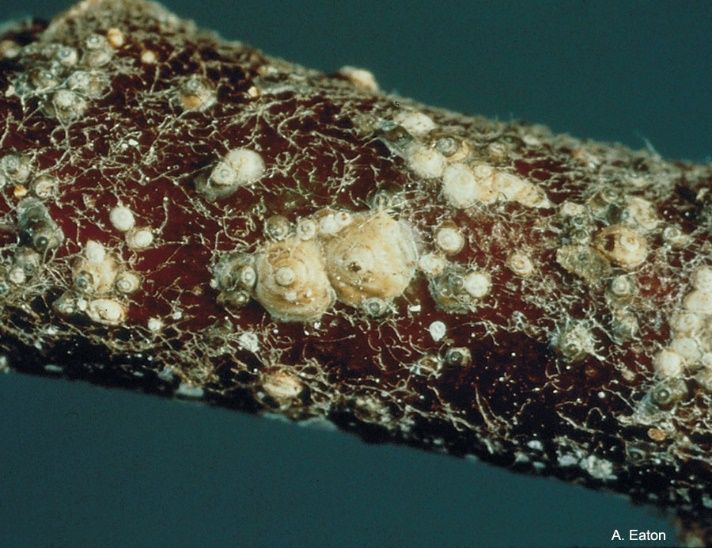
Credit: Alan Eaton, UNH
Plum Curculio
The plum curculio (also known as a true weevil) is a common pest of stone fruit and apple. When the female plum curculio chooses a host, it makes an egg “chamber” under the fruit skin that will receive the egg. Afterwards it will place an egg in the cavity of the fruit. Making a small crescent-shaped cut on the outside immature fruit, it deposits an egg in the flap of the flesh. The eggs rapidly hatch, and the larvae (small, whitish worms) migrate to the fruit interior, effectively killing and making the apple fall to the ground.
Catfacing Insects
The term “catfacing” is the physical injury to the fruit caused by insects. Some notable insects that cause catfacing are stinkbugs, tarnished plant bugs, and leaf-footed bugs. The catfacing insects typically feed during early fruit development and cause fruit deformities. Unfortunately, feeding during mid-to-late fruit development can facilitate pathogen entry into the fruit and exacerbate fungal disease incidence.
Mites
The two-spotted spider mite (Tetranychus urticae) and the European red mite (Panonyochus ulmi) infests the leaves of apple trees, particularly during dry summer weather. A beneficial way to keep the mites under control and prevent outbreaks would be to cultivate their natural enemies, such as the ladybug species (Harmonia acyridis).
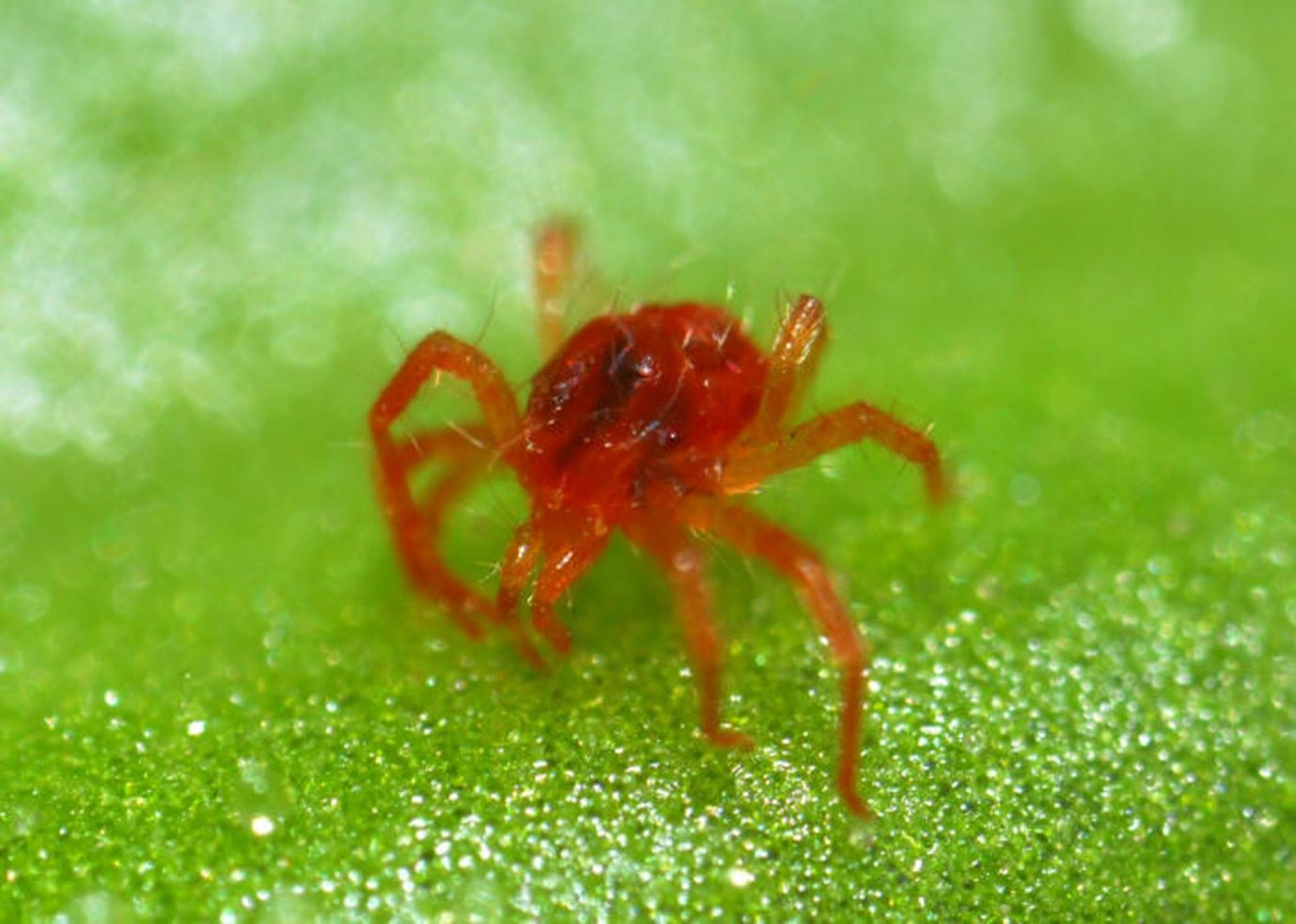
Credit: Makoto Honda
Wooly Apple Aphid
The wooly apple aphid (Eriosoma lanigerum) is a ubiquitous insect pest that affects apples. Nymphs are covered with a filamentous wax that appears as tufts of fibers on branches, twigs and bark. Colonies are characterized by dense, white, woollike coverings. Observation of wooly apple aphid on aerial tissues typically indicates infestation of the roots, where the insect does the most damage. Damage to roots results in yellowing of leaves and eventually destabilization of the tree. A number of rootstocks (such as MM106 and MM111) confer resistance to wooly apple aphid.
Diseases
Apple Scab
Apple scab is a common fungal disease, caused by Venturia inaequalis. It affects leaves, flowers, and fruit. Lesions will develop on both leaf surfaces, which results in leaf distortion. Scabby, dark spots are clearly seen on infested fruit. In regions having a warm climate, these spots commonly appear as scars as the fruit matures. Previous infection of immature fruit results in cracking and distortion of the area associated with the scab lesions. Efficient control of apple scab may be achieved by fungicide applications.
Fireblight
This bacterial disease, induced by Erwinia amylovora, spreads from tree to tree primarily during bloom. Fireblight is normally only a severe problem during a prolonged cool period in the spring. Typically, shoot tips become blackened and appear as if they have been burned. Fireblight can generally be controlled by reducing nitrogen fertilizer, which results in overvigorous growth. When fireblight infection is present, the infected area should be pruned out, cutting at least 8–10 inches below the lowest visible site of infection. The pruned-off limbs then should be burned.
Botryosphaeria Canker
This fungal disease, also known as white rot, is still by far the most debilitating disease of apple trees in Florida. It is caused by several Botryosphaeria species. It only attacks plants that are already stressed or weakened by other pathogens. Twig cankers first appear as water-soaked spots, which eventually enlarge and produce rings of black fruiting structures. This canker can spread from twigs to scaffold limbs and eventually to the trunk, causing bark to darken and slough off. The fungus is spread as spores, particularly during wet and humid weather. Botryosphaeris is especially severe from June through August. Fruit infection can also occur and appear as small circular brown spots with red borders. Prevention consists of pruning and removal of infected wood. Pruning cuts should be made beyond the area of visible infection into healthy tissue. Sadly, there is no satisfactory chemical control.
Bitter Rot
This fungal disease, incited by Colletotrichum gloeosporioides, infects the fruit, but causes stem cankers. Bitter rot on the fruit starts as a small, circular, light-brown area. Spots enlarge rapidly and become darkened. A distinctive characteristic is a saucer-shaped depression with fruiting structures in center and concentric rings to the periphery. Stem cankers should be pruned out and burned.
Mushroom Root Rot
This fungal disease, incited by Armillaria tabescens, attacks the roots and can result in tree death. Armillaria produces rhizomorphs (the root-like structures) that attack living trees. They can grow up to 70 feet away from the initial infection site. When the rhizomorphs encounter a potential host’s root system, it causes growth problems and in the long term, girdles the tree. The larger and more mature trees can compartmentalize the infection and survive for years. Unfortunately, it can only fight it for so long and will eventually succumb to the infection. The disease is especially problematic in recently cleared land that contains residual tree roots. These roots can serve as a source of inoculum. In diseased trees, the foliage turns yellow and then brown. White layers of fungus appear underneath the bark at the soil line, and mushroomlike fruiting bodies may emerge from the lower trunk or from roots located close to the soil surface. No satisfactory chemical control is available.
Nuisance Mammal
Rabbit
Rabbits eat the bark of apple trees during the winter months and can kill the tree. The problem is not that they just eat the bark, but that they also eat the living tissues underneath, which affects the vascular system. Without the vascular system the tree will starve to death. For best control, a physical barrier such as hardware cloth or plastic tree guards should be placed around the trunk of the tree.
References
Carlson, R. F., and J. H. Hull, Jr. 1975. Rootstocks for Fruit Trees. Michigan State University Extension Bulletin No. E-851. 2 pp.
Cummins, J. N., and H. S. Aldwinckle. 1982. "New and Forthcoming Apple Rootstocks." Fruit Var. J. 36 (3): 66–73.
Miller, E. P., and L. H. Baker. 1982. "An Evaluation of Apple Cultivars for Central and North Florida." Proc. Fla. State Hort. Soc. 95:88–90.
Westwood, M. N. 1978. Temperate Zone Pomology. San Francisco: W. H. Freeman and Co.
Table 1. Adaption, quality, and origin of apple cultivars tested in north Florida and north central Florida.
Table 2. Fruit quality of apple cultivars for Florida.
Table 3. Trunk diameter and tree height of third leaf for 'Anna' and 'Dorsett Golden' apple trees on four dwarfing rootstocks.
Table 4. Characteristics of four dwarfing apple rootstocks.z